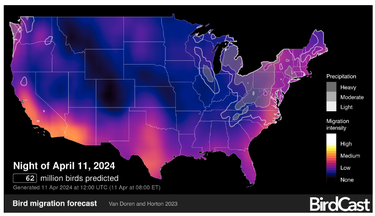Lights Out for migrating birds
Birds are on the move — largely migrating in the dark.
Lights can confuse them and even kill them.
The state announced this week that it is once again participating in the “Lights Out” initiative, joining national and international efforts to turn off nonessential outdoor lights on state buildings.
“We all play a role in protecting the environment and wildlife and the national Lights Out initiative is a simple way to help a variety of bird species survive and thrive during the busy migration season,” said Department of Environmental Conservation Commissioner Basil Seggos in a release announcing the initiative.
Many species of shorebirds and songbirds rely on constellations to help them navigate to and from their summer breeding grounds through the state. Excessive outdoor lighting, especially in adverse weather conditions, can cause migrating birds to become disoriented, a phenomenon known as fatal light attraction.
According to the National Zoological Park and the U.S. Fish and Wildlife Service, fatal light attraction has led to collisions with windows, walls, floodlights, or the ground and the death of an estimated 365 to 988 million birds annually in the United States.
Lights Out directs state-owned and managed buildings to turn off nonessential outdoor lighting from 11 p.m. to dawn during the spring migration, from April 15 through May 31, and also during the peak fall migration, from Aug. 15 through Nov. 15.
State agencies, the release says, are also encouraged to draw blinds, when possible, and turn off nonessential indoor lighting during Lights Out times. In addition to benefiting migrating birds, the release says, Lights Out promotes sustainability and provides a cost-savings to the state.
Individuals can follow the same protocols with their homes and businesses, as urged by BirdCast, a program run by Cornell University.
Cornell Lab of Ornithology produces interactive maps that allow people to track bird migration anywhere in the United States. Real-time analysis shows intensities of actual nocturnal bird migration as detected by the U.S. weather surveillance radar network between local sunset to sunrise.
“Light pollution attracts and disorients migrating birds, confusing and exhausting them as well as making them vulnerable to collisions with buildings, not to mention other urban threats like cats and toxins,” says BirdCast.
An estimated 365 to 988 million birds die in collisions with buildings annually, including a number of species of high conservation concern, BirdCast says, noting the growing international Lights Out effort includes in over 30 cities in North America.
During migration periods, BirdCast advises, from 11 a.m. to 6 p.m., turn off or dim lobby and atrium lights; turn off or dim interior home lighting, or draw blinds to prevent light escaping; turn off decorative landscape lighting; turn off lights before leaving the home or office; be sure outside lights are aimed down and well shielded; and install motion sensors on outside lights to minimize use.
BirdCast also advises preventing daylight collisions with bird friendly products for windows.

